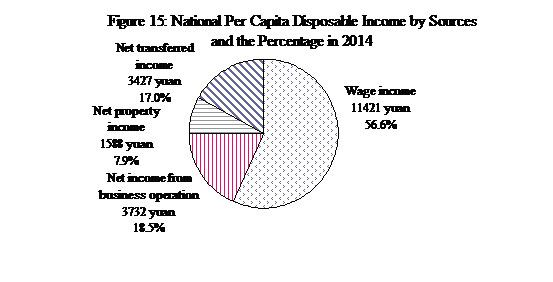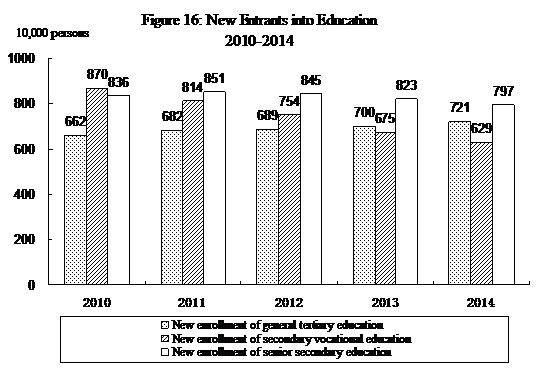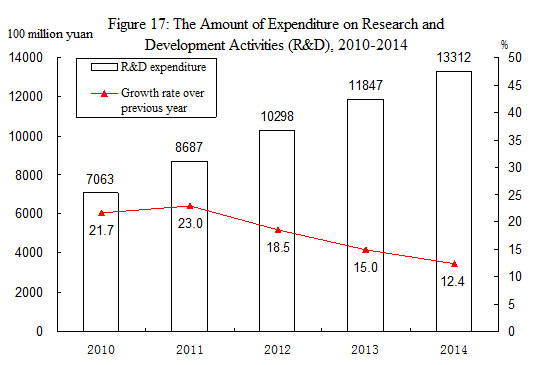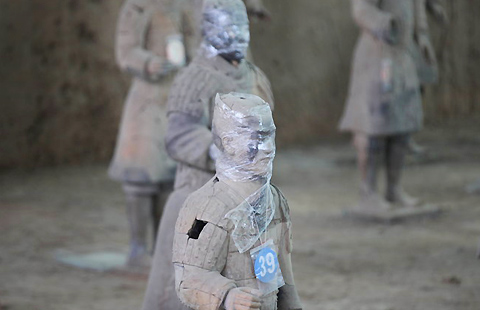
IX. Living Conditions and Social Security
The income of urban and rural residents continued to rise. In 2014, the national per capita disposable income was 20,167 yuan, an increase of 10.1 percent or a real increase of 8.0 percent after deducting price factors. In terms of permanent residence, the per capita disposable income of urban households[28] was 28,844 yuan, up by 9.0 percent, or a real growth of 6.8 percent after deducting price factors. The median[29] of per capita disposable income of urban households was 26,635 yuan, up by 10.3 percent. The per capita disposable income of rural residents was 10,489 yuan, up by 11.2 percent, or 9.2 percent in real terms. The median of per capita disposable income of rural residents was 9,497 yuan, up by 12.7 percent. In 2014, the annual per capita net income of rural residents was 9,892 yuan. The national per capita consumption expenditure was 14,491 yuan, up by 9.6 percent, or a real growth of 7.5 percent after deducting price factors. In terms of permanent residence, the per capita consumption expenditure of urban households was 19,968 yuan, up by 8.0 percent, or 5.8 percent in real terms. The per capita consumption expenditure of rural residents was 8,383 yuan, up by 12.0 percent, or a real growth of 10.0 percent after deducting price factors.
 |
Social security made new progress. By the end of 2014, a total of 341.15 million people participated in urban basic pension program for staff and workers, a year-on-year increase of 18.97 million. A total of 501.07 million people participated in basic pension insurance program for urban and rural residents, an increase of 3.57 million. A total of 597.74 million people participated in basic health insurance program, an increase of 27.02 million, of whom, 283.25 million people participated in basic health insurance program for staff and workers, a year-on-year increase of 8.82 million, and 314.49 million people participated in programs for residents, an increase of 18.20 million. Some 170.43 million people participated in unemployment insurance programs, an increase of 6.26 million. The number of people receiving unemployment insurance payment stood at 2.07 million. A total of 206.21 million people participated in work accident insurance, an increase of 7.03 million, of whom 73.62 million were migrant workers, an increase of 0.98 million. A total of 170.35 million people participated in maternity insurance programs, an increase of 6.43 million. According to the rural poverty line of annual per capita income of 2,300 yuan (at 2010 constant prices), the population in poverty in rural areas numbered 70.17 million in 2014, or 12.32 million less than that in 2013.
X. Education, Science & Technology and Culture & Sports
The education, science & technology and culture & sports undertakings developed at a rapid pace. In 2014, the post-graduate education enrollment was 1.848 million students with 621 thousand new students and 536 thousand graduates. The general tertiary education enrollment was 25.477 million students with 7.214 million new students and 6.594 million graduates. Vocational secondary schools[30] had 18.029 million enrolled students, including 6.289 million new entrants, and 6.330 million graduates. Senior secondary schools had 24.005 million enrolled students, including 7.966 million new entrants, and 7.996 million graduates. Students enrolled in junior secondary schools totaled 43.846 million, including 14.478 million new entrants, and 14.135 million graduates. The country had a primary education enrollment of 94.511 million students, including 16.584 million new entrants, and 14.766 million graduates. There were 395 thousand students enrolled in special education schools, with 71 thousand new entrants and 49 thousand graduates. Kindergartens accommodated 40.507 million children.
 |
Expenditures on research and development activities (R&D) was worth 1,331.2 billion yuan in 2014, up 12.4 percent over 2013, accounting for 2.09 percent of GDP. Of this total, 62.6 billion yuan was appropriated for fundamental research programs. A total number of 3,997 projects under the National Key Technology Research and Development Program and 2,129 projects under the Hi-tech Research and Development Program (the 863 Program) were implemented. By the end of 2014, there were altogether 132 national engineering research centers and 154 national engineering laboratories. The number of state validated enterprise technical centers reached 1,098. Accumulatively, 213 venture investment enterprises were established under the support of State Venture Capital Investment Plans[31] for Emerging Industries, with a total fund size approaching 57.4 billion yuan, and an investment to 739 venture businesses. Some 2,361 thousand patent applications were accepted from home and abroad, and a total of 1,303 thousand patents were authorized. Till the end of year 2014, the number of patents in force was 4.643 million. A total of 297 thousand technology transfer contracts were signed, representing 857.7 billion yuan in value, up 14.8 percent over the previous year.
 |
|
Table16: Number of Patents Application Accepted, Patents Authorized and Patents in Force |
||
|
Item |
Patents(10,000) |
Increase over 2013(%) |
|
Number of patent applications accepted |
236.1 |
-0.7 |
|
Of which: domestic |
218.6 |
-1.0 |
|
Of which: for new inventions |
92.8 |
12.5 |
|
Of which: domestic |
79.0 |
13.9 |
|
Number of patents authorized |
130.3 |
-0.8 |
|
Of which: domestic |
119.2 |
-1.5 |
|
Of which: for new inventions |
23.3 |
12.3 |
|
Of which: domestic |
15.8 |
14.1 |
|
Number of patents in force at the end of the year |
464.3 |
10.7 |
|
Of which: domestic |
391.8 |
11.1 |
|
Of which: for new inventions |
119.6 |
15.7 |
|
Of which: domestic |
66.3 |
21.7 |
The year 2014 saw 16 times of successful launch of satellites. The reentry test of the third phase of lunar exploration project was completed successfully. Gaofen-2 satellite had a successful launch.
By the end of 2014, there were altogether 27,051 laboratories for product inspection, including








